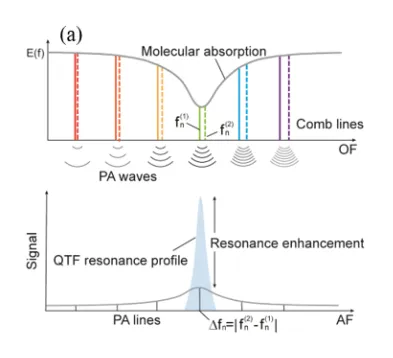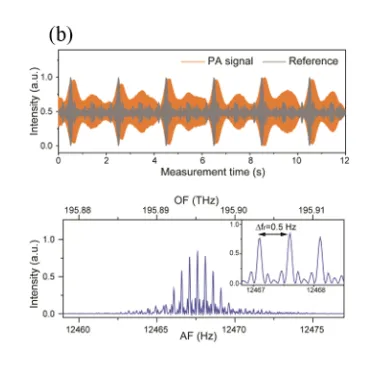Precision measurement physics has achieved unprecedented accuracy in manipulating and measuring atoms, not only bringing about a series of major scientific discoveries, but also promoting the rapid development of time-frequency precision measurement technology. However, molecular spectrum measurement is not only lagging behind in principle and methods, but also in technical instruments. Improving the accuracy of molecular spectrum measurement has become a very important scientific goal in this century. The high-resolution spectral identification based on high-precision optical frequency measurement is limited to a narrow frequency band range. Nevertheless, conventional high-resolution spectral measurement methods still cannot avoid the molecular Doppler broadening effect, and high-precision frequency measurement cannot be effectively transformed into accurate determination of molecular spectral lines. There is a serious technical disconnect between the development of optical field time-frequency precision manipulation technology and high-resolution spectral measurement. Breaking through the Doppler limit requires nonlinear spectral measurement methods, but existing nonlinear technologies require strict time-frequency coherence and light intensity of light sources, which cannot meet the application requirements of full band molecular fingerprint spectral detection.
In this research, to address this issue, Professor Zeng Heping's research group proposed and experimentally implemented a nonlinear dual comb photoacoustic spectroscopy technique based on tuning fork resonance enhancement. In this technology, the manipulation of molecular vibrational energy level transitions by a three beam comb light field can achieve nonlinear spectral "hole burning" effect in the acoustic signal induced by molecular vibration, thereby overcoming the limitations of uniform broadening effect on spectral line measurement resolution and accuracy. Simultaneously combining acoustic microcavities and tuning fork resonance effects to improve detection sensitivity. This work provides an ultra-high resolution spectral measurement method for the application of gas sensing and trace analysis.
In the experiment, as shown in Figure 1 (a), a dual comb light field with different comb tooth spacing (pulse repetition frequency) produces a sound comb with beat frequency characteristics through the photoacoustic effect of molecular absorption. The sonic comb carries molecular characteristic peak information (line shape, frequency, and line strength) and is detected by a sonic sensor (tuning fork). As shown in Figure 1 (b), the time-domain signal can obtain the molecular spectral line information in the frequency domain through the Fourier transform algorithm. By using an infrared light field as the pump light to saturate the molecular vibrational energy level, and then detecting it through optical double comb sound waves, the Doppler spectral line broadening effect can be effectively suppressed, achieving one-time, fast, and high-resolution measurement of uniformly widened molecular lines (such as collision broadening). As shown in Figure 1 (c), the experiment achieved sub Doppler resolution (10 MMHz) measurement of acetylene gas molecules, with a spectral line width of only 45.8MHz, which is nearly an order of magnitude higher than the Doppler limit resolution (470MHz). The research findings were published in Photoacoustics 28, 100403 (2022).

(a) Schematic diagram of dual comb photoacoustic spectroscopy

(b) Experimental results of tuning fork enhanced dual comb spectroscopy
(c) Doppler experiment results
Source:【科研动态】非线性双光梳光声光谱测量 (qq.com)
Paper Link:https://doi.org/10.1016/j.pacs.2022.100403

